Orfeó Atlàntida Brief History
The origins - The development - The parenthesis - The revival - 50th Anniversary - 75th Anniversary - Hostafrancs Cultural Foundation - 85th Anniversary - The present - Conductors - Presidents
The Orfeó Atlàntida choir, is one of the oldest choral institutions in Catalonia, founded in 1926 in the Barcelona district of Hostafrancs. During more than eighty years, the choir gradually and naturally adapted its repertoire to the signs of the times. Its broad repertory includes works from the Renaissance to nowadays, passing through the Negro spirituals, sacred music, Mozart's Coronation Mass, Schubert's Mass in D, Vivaldi's Gloria and Magnificat, Brückner's Te Deum , Puccini's Mass of Glory, opera choruses, 20th century music, and Broadway musicals chorus, paying special attention to the Catalan traditional music.
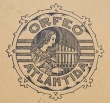
The Origins Top
Since its creation in 1926, Orfeó Atlàntida is an entity linked to the Hostafrancs district, a predominantly working class district of Barcelona. There are no many details left about its foundation since its archives were damaged by the Civil War. However we know that most of the founders were workers from Hostafrancs and Sants who had already had some experience in choral singing.
We can however distinguish some features of this growing choir through its etymology:
- It's an "Orfeó", which means a choir entity with mixed voices. Unlike veterans choral societies such as the "Clavé", they decided to follow the example of the famous "Orfeó Català" a much younger choir and 'the' optimum reference in this field;
- Its name was chosen in reference to Verdaguer, the 'prince of catalan poets', and his poem 'La Atlàntida", which refers to the strong Catalan character of the entity.
As an entity, it also managed to survive as time went on, thanks to a constant effort, a firm will and an important musical vocation of all its members since May 12, 1926 (date of its foundation) until now.
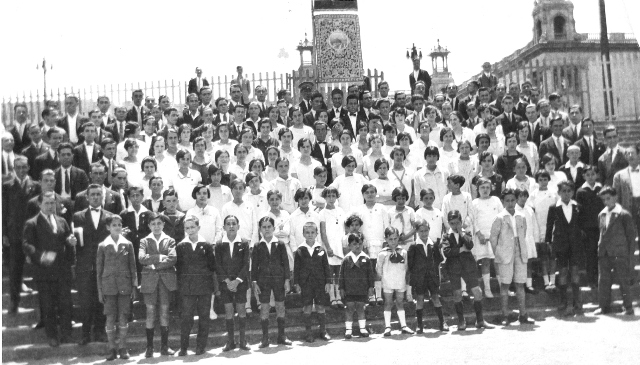
The development Top
The Orfeó Atlàntida began its musical activities at 18 Consell de Cent street, in a venue known as "Sang Nova" (New blood) and with a total of over two hundred singers.
In this place, whose name was quite suggestive, the choir prepared for its baptism. At that time it was a tradition to bless the flag of the choral society. This religious ceremony was held in 1927 at the Montserrat basilica and was presided over by the abbot, Father Antoni M. Marcet.
The beginning was exciting as the Orfeó performed for the famous conductors Lluís Millet, founder of the Orfeó Català, and Joan Llongueras, founder of the "Institut Català d'Arts i Ritme". .
The concerts were to happen quickly: among others, the Orfeó sang at the Coliseum Theater in Barcelona and at the Palau de la Música Catalana taking part in the concerts organized by the Workers' Music Association founded by Pau (Pablo) Casals.
At the end of the second year, 232 singers formed the choir. But growth did not only affect the number of singers. It helped improving the qualitative level of the society, building a more organized structure little by little: new sections were created such as «l'Esbart Dansaire» folk dancing school, a “Sardanas” school, hiking and photography sections, etc… All those events transformed the choir into a very prized leisure activities center very prized by the society at that time.
The Orfeó throve well for 10 years and changed its address to 23 Consell de Cent street until…
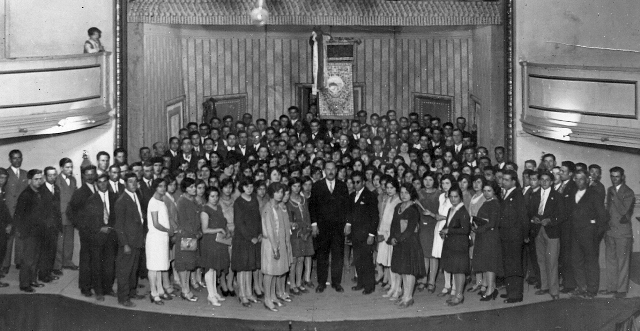
The parenthesis Top
The military uprising in 1936 and the subsequent Civil War burst into the activities of all the cultural institutions in Catalonia, which were suspended. The young Orfeó Atlàntida was not an exception. In 1937, armed political men of the Republican Action confiscated the premise. The choir searched for refuge in another place in the neighborhood, at the Catalan Nationalist Party, but this premise was also closed at the beginning of 1939 by the new fascist authorities...
The revival Top
The war was over and a long and sad after-war period started. Until 1951, the Orfeó could not start its activities again. Relocated at its former "New Blood” premise, the circumstances led to a new change of premise in 1955. In 1956 the Orfeó would accommodate in the Sports Society of the "España Industrial" factory. During these times when the choir would continue refining and broadening its repertoire, while its sections fully developed. After some vicissitudes, the choir had to change location: it went first to the headquarters of Ateneo Montserrat until 1967. Then a big loft was hired at 30 Consell de Cent street where the choir spent more than 30 years...
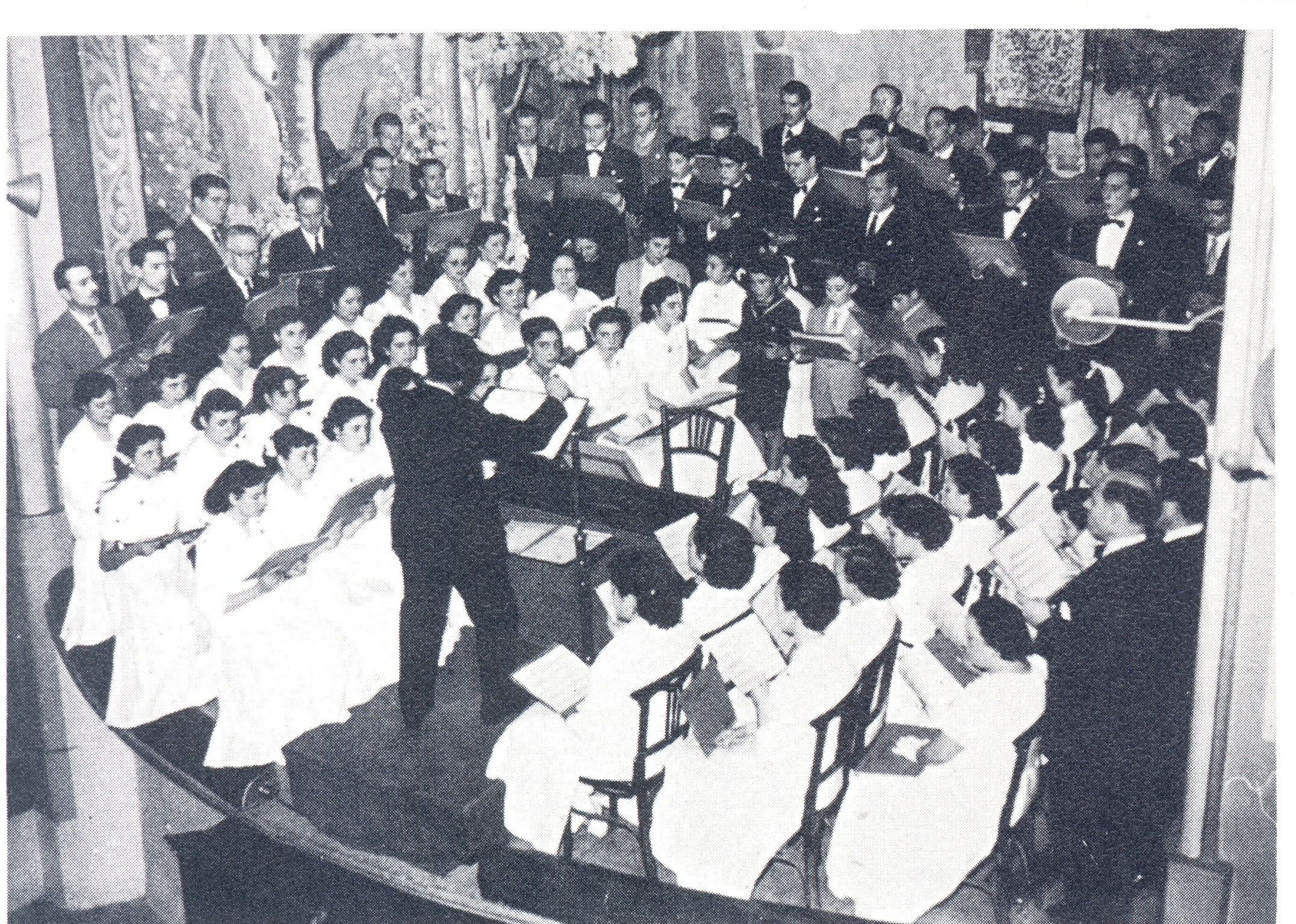
1976: 50th Anniversary Top
Several events are organized to commemorate the half century of the Orfeó along the year:
- The Orfeó Atlàntida history is published in a book written by an illustrious Hostafrancs neighbor, Dr Joan Pelegrí i Partegàs.
- In order to recall the blessing of the Orfeo’s flag, another visit to Montserrat is organised under the aegis of Cassià M. Just abbot.
- The most significant event is the concert organized in "Saló del Tinell", Barcelona, which brought together three generations of singers:
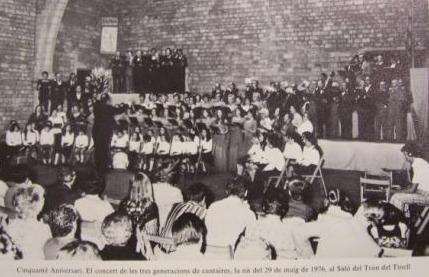
2001: 75th Anniversary Top
There were many events to celebrate the anniversary, including the closing concert, with orchestra and soloists, held in Barcelona Winterthur Auditorium. The main part of the concert was the Coronation Mass (KV317) by W. A. Mozart, wich was recorded on CD and put on sale.
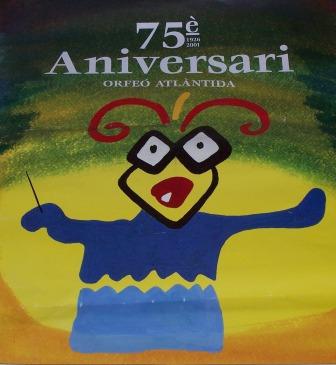
The Orfeó and the Hostafrancs Cultural Foundation (FCH) Top
Recently, the board felt the need to approach its activities to the neighborhood, and find a newer and more accessible place. To achieve these objectives, the Orfeó Atlàntida got in touch with the Fundació Cultural Hostafrancs (FCH) in 2003 to evaluate if it could incorporate into this established and prestigious cultural institution of the neighborhood. The negotiation would bear fruit and in 2004 the choir moved its headquarters to those of FCH, in 6-8 Torre Damians street, close to the former site. As a result of this integration, the choir now enjoys a spacious building for rehearsals and performances.
2011: 85th anniversary Top
To celebrate the 85th anniversary, the Orfeó organized - among other events - a concert at the Auditorium of Barcelona, together with the Cor de Cambra Dyapason. The concert took place on 15 May 2011 at the Oriol Martorell Hall of the the Auditorium.
In the first part, some of the repertoire a cappella works were performed, and in the second the Messa di Gloria by Giacomo Puccini with the Orchestra de Cambra del Empordà, tenor and baritone soloists.
We were lucky to have Mons. Valentí Miserachs, director of the "Pontificio Istituto di Musica Sacra" of Rome conducting the Messa di Gloria, work in which he is an specialist.
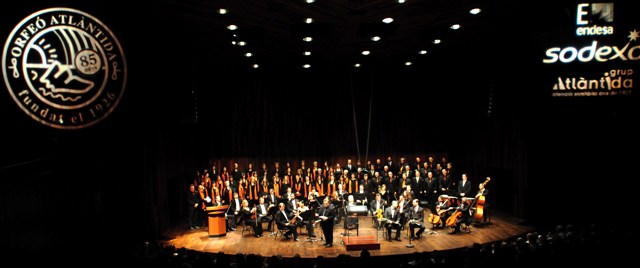
The present Top
Nowadays, the entity consists of 130 members, 50 of whom are singers. Some of these singers come from formerly very active children choirs and young chamber choirs, conducted by Meritxell Forner and Sonia Torner, respectively.
The choir has a varied repertoire that ranges from songs of the fifteenth century to contemporary Broadway musicals, from Sardana and Catalan folk songs to pieces by Mozart and Vivaldi. It must be said that, in musicals, a certain dramatic interpretation adds to the traditional vocal performance, thereby adjusting the choir to the new trends and the new choral tastes of the public.
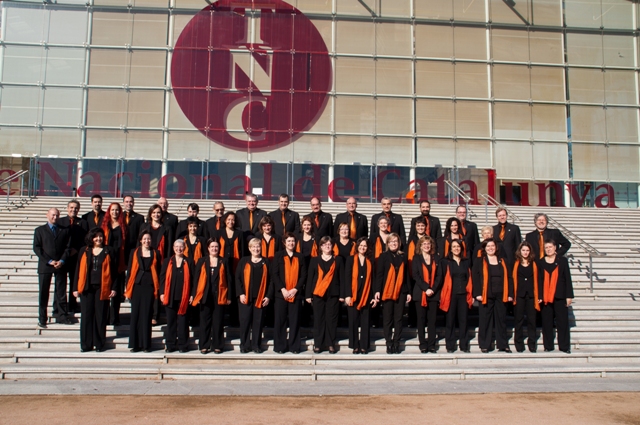
Conductors Top
Throughout its history, the Orfeó Atlàntida has had the invaluable dedication of several conductors, each of which has brought their particular way of understanding the choral and musical direction.
We could not forget Norman Soler (1926-1930, 1951-1955), founder of the choir, Joan Sunyer i Cintes (1930-1936), organist of the great and wasted organ of the National Palace of Montjuic (today MNAC). Francesc Folguera (1955-1961) while respecting most of the old repertoire, added new works to the choir to inspire a new and exquisite interpretation.
Antoni Coll i Cruells (1961-1997), who was able to maintain and even improve the level of interpretation: we would like to highlight that during this long period, the choir was directed by a single direction: "Mestre" Coll, who was in front of the choir for 36 consecutive years, in which the entity reached important achievements. Professor Domènec Olivella, who led the baton of the choir during the period 1998-2004 and so during the 75th Anniversary. The choir pays homage and gratitude to all (dead or alive) for their work.
1926-1930 - Normand Soler
1930-1936 - Joan Sunyer i Sintes
1951-1954 - Normand Soler / Ass. Director: Francesc Guivernau
1955-1961 - Francesc Folguera
1961-1997 - Antoni Coll i Cruells / Ass. Directors: Rita Torres, Francesc Guivernau, Carles Pongiluppi & Teo Roura
1997-1998 - Jordi Gargallo
1998-2004 - Domènec Olivella
2004-2005 - Sònia Torner i Molins
2007-2013 - Murat Khúpov (Ass. Director)
2005- ------ - Milén P.Panayótov
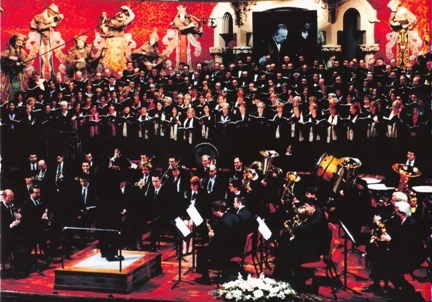
Presidents Top
1926-1929 - Miquel Guixà i Caselles
1929-1930 - Joan Altimir i Sobrey
1930-1932 - Joan Mestres i Coll
1932-1933 - Joan Rallé i Sans
1933-1935 - Marcel Blanch i Mayol
1935-1936 - Tomàs Benedico i Bergua
1936-1937 - Josep Garcia i Cases
1951-1953 - Antoni Sancho i Vallet
1954-1961 - Antoni Ramon i Borrós
1962-1965 - Joan Cuatrecasas i Cortès
1965-1966 - Josep Nogué i Montanyès
1967-1971 - Josep Gosalves i Llobregat
1971-1977 - Ramon Morera i Oliveras
1977-1978 - Josep León i Humbert
1978-1980 - Enric Bahí i Guasch
1980-1984 - Ramon Morera i Oliveras
1984-1990 - Joan Cuatrecasas i Cuadrat
1990-1990 - Albert Yrurzun i Andreu
1990-1994 - Ramon Morera i Oliveras
1994-1997 - Salvador Molins i Bagaria
1997-2001 - Jaume Forner i Gómez
2001-2002 - Ramon Morera i Oliveras (acting)
2002-2006 - Lluís Cuatrecasas i Albareda
2006-2012 - David Forner i Bofill
2012- ----- - Anna Cuatrecasas i Albareda















